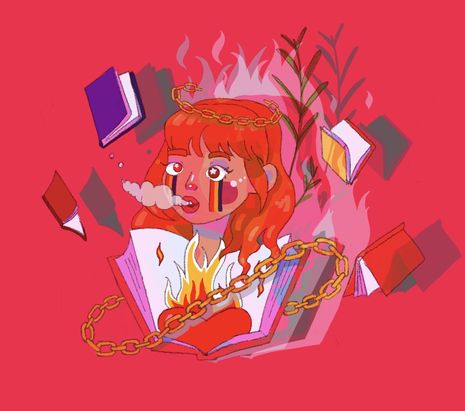Are ‘cult classics’ actually cults?
Arts columnist Sophie Long debates the origins and reception of modern ‘cult classics’, thinking about the phenomena in relation to cults themselves

Underground novels of great impact that target a small audience entirely dedicated to the underdog author that writes them are often affectionately coined ‘cult classics’. The ‘cult’ has evolved from its Latin meaning of ‘care’ or ‘adoration’ to a modern extremity of indoctrinated devotion. The traditional collection of American cult classic authors – Kesey, Kerouac, Burroughs, Bukowski – all have their dedicated superfans in common. They come from backgrounds filled with stoner machismo and an inherent dislike of the institution that surrounds their writing. They do not write for acclaim, though they often receive it – and, instead, write in pursuit of like-minded individuals. The dedicated ‘cult follower’ ingests their work indiscriminately, often protecting its breach into mainstream consumption that can lead to the dissolution of the ‘cult’ label.
"It begs the question of whether it is possible to exist in the mainstream whilst also tapping into the cult mindset"
The true definition of ‘cult fiction’ is elusive and struggles to be tied down to a set of conventions or a particular audience. It would be easier to categorise the cult novel as an ‘experience of identification.’ Jane Sullivan, writing about the appeal of cult fiction, says that it is a work that the reader is convinced only they understand, and that the author speaks to them directly. You need only look at the effect of successful cult leaders to understand the draw of an author’s work. The infamous David Koresh of the Waco, Texas Branch Davidians seamlessly cultivated a dedicated following by proclaiming himself to be a final prophet: a figure of higher knowledge and higher being that is replicated in the veneration of our favourite authors. However, there is a distinct difference between a purposeful cult leader and a nominated figurehead. David Koresh and Charles Manson are incomparable to authors, or movie stars, or musicians. The craze of Beatlemania, or the devoted ‘stan’ cultures of current celebrities do not share the purposes of legitimate cult leaders, but the dedication of their followers are seamlessly mirrored.
The possibility of cult fiction is in part owed to the trial of Lady Chatterley’s Lover in 1960. Starting in Britain, censorship laws waning opened up a new sector of literature focusing on the gritty, gory and uncomfortable parts of life otherwise omitted from the literary scene. Across the pond, American publishing houses began publishing realistic depictions of inner city violence and truthful accounts of mental health struggles and addiction. What remains true in the connection between cult and cult fiction is its insularity. The success of a cult classic is in its ability to identify with its readership, and the ability to write experience truthfully increases the likelihood of finding these readers.
"The dedicated ‘cult follower’ ingests writers' work indiscriminately"
Passionate dedication comes in smaller forms, and therefore critics of the ‘cult fiction’ genre speculate as to whether mainstream literary awards and institutions can remove cult status. Take the conundrum of Zen and the Art of Motorcycle Maintenance by Robert M. Pirsig as an example –initially rejected 121 times by publishers, the novel has since been granted ‘cult status’ despite appearing on some of the most prestigious bestsellers lists of all time. It begs the question of whether it is possible to exist in the mainstream while also tapping into the cult mindset. Exposure widens audience reach, eventually creating the spectrum of casual readers, fans and superfans. It seems reductive to point out that casual participation in a cult is impossible, but it is true that to have a varying dedication to readership is not the supposed ‘cult’ status we anticipate works to achieve.
So, how can novels such as On the Road or One Flew Over the Cuckoo’s Nest truly be cult classics if their reach is far and wide? Instead, should we propose that the work must be confined to the literary world and available to a limited number of readers? My proposal for a modern day cult writer would be US-based Ottessa Moshfegh, with her novels My Year of Rest and Relaxation and Eileen. Her novels carry the edge that all cult classics share by exposing the struggles of isolation and depression, and the resultant rage against society. The unnamed narrator of My Year of Rest and Relaxation journeys past the masculine stoner characters of the American 1960s to a highly medicated, dreary image of modern New York. Moshfegh received positive reviews in several distinguished literary journals, but since her shortlist for the 2016 Man Booker Prize, Moshfegh has avoided a grand launch into the mainstream. For the moment, she remains in literary circles by avoiding the intersection of her work with film or stage production. Moshfegh’s most recent publication, Death in Her Hands (2020) has stalled her positive critical reception, possibly pulling her back to the underground world of the cult leader and their following.
Although it feels less than complimentary to exchange acclaim for the crown of cult leader, Moshfegh undoubtedly joins a growing list of authors known for writing a true and resonant experience. Whether she joins the ever-growing list of cult leaders is questionable, as is the desire to be deemed a ‘cult leader’ in a time of extremist fan bases and ‘stan’ culture.
 News / Clare Hall spent over £500k opposing busway 24 December 2025
News / Clare Hall spent over £500k opposing busway 24 December 2025 Comment / The ‘class’ of Cambridge24 December 2025
Comment / The ‘class’ of Cambridge24 December 2025 News / Caius mourns its tree-mendous loss23 December 2025
News / Caius mourns its tree-mendous loss23 December 2025 Comment / Yes, I’m brown – but I have more important things to say22 December 2025
Comment / Yes, I’m brown – but I have more important things to say22 December 2025 News / Girton JCR publishes open letter expressing solidarity with Palestine25 December 2025
News / Girton JCR publishes open letter expressing solidarity with Palestine25 December 2025










